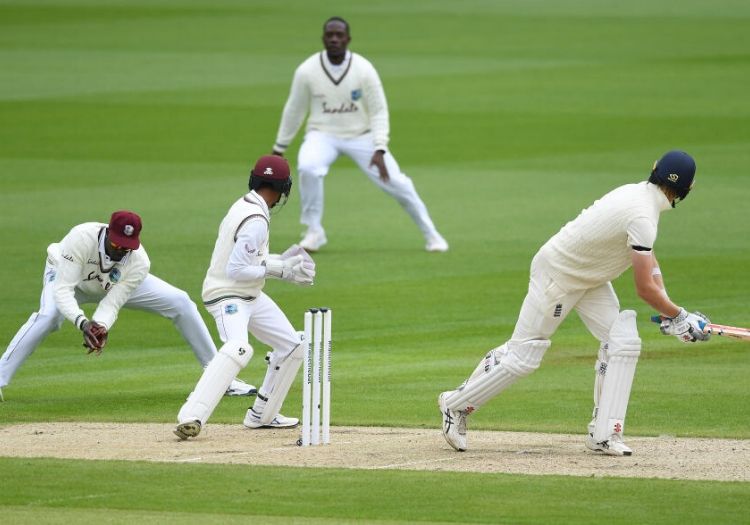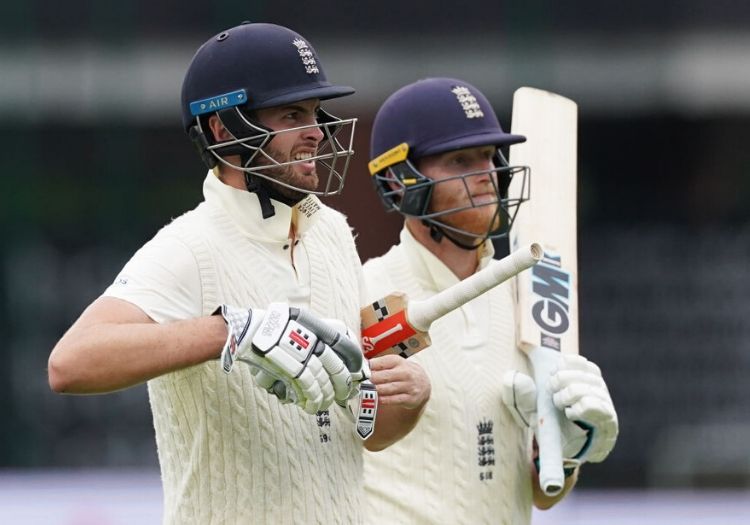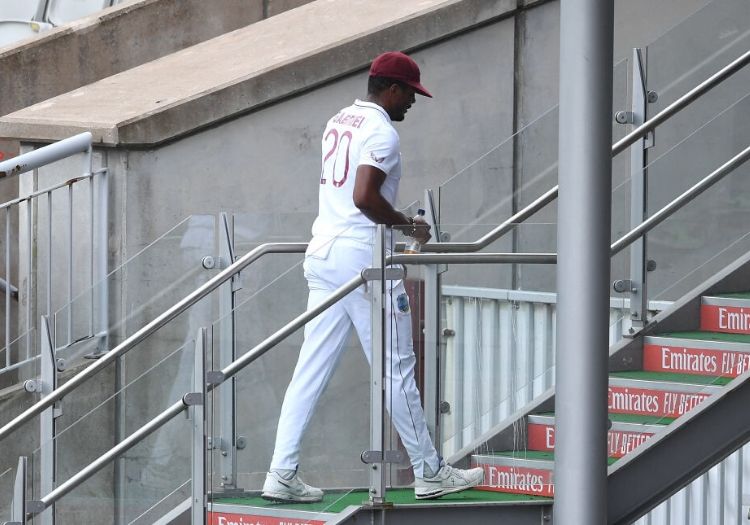NICK FRIEND looks back on an eventful first day of the second Test between England and West Indies at Emirates Old Trafford, an occasion that began with Jofra Archer's protocol breach and ended with runs for Dom Sibley and wickets for Roston Chase

Jofra Archer was misguided in his decision to take a detour to his Hove flat en route to Emirates Old Trafford. No more, no less: certainly not – on the face of it – the most scandalous of transgressions, but still a serious misjudgement in the context of an exceptional summer.
Is it an error that requires a discussion about character or attitude or commitment or any other such buzzword? Absolutely not.
Is it an error that will frustrate many – not least himself, having bowled so beautifully on the final day in Southampton, and those who have worked so hard to greenlight this series? Yes, of course.
English cricket, led by Steve Elworthy, has been nothing if not meticulous in all it has done to reach this current point. Rewind a couple of months and even the notion of international cricket seemed a far-fetched pipedream. Thus, the conditions in place have had to be thorough and rigorous. As ECB safety manager Phil Davies put in a pre-series briefing to the written press: “When this is all over, we would prefer people to say this was a massive overreaction than the other way around.”
Chris Stocks, the sole freelance written journalist on site, wrote following the conclusion of the Ageas Bowl Test: “The detail in the planning, which we all received in a 74-page booklet that set out all the protocols before the series began, is remarkable.”
There was enough concern when Sam Curran came down with a sickness bug during an intra-squad practice match ahead of the first Test to realise then quite how important it was that all went without alarm. Had Curran returned a positive test, who knows what would have followed?
To clarify, Archer has not been punished, per se. Missing this game is not so much a sanction as a protocol; he must self-isolate for five days and undergo two Covid-19 tests before his solitary period is lifted. The same was the case for West Indies coach Phil Simmons, who briefly left the team bubble on compassionate leave in June. He returned on June 26, before being given the all-clear to resume his participation once he had passed a final precautionary test on July 1.
Early reports on Thursday that Archer’s whereabouts was discovered by a tracking system attached to accreditation cards have been quashed.
“To be clear, the track and trace chip attached to accreditation for all stakeholders, whether you're a player or media, are for the venues only,” an ECB statement read. “They only work in venue. We do not track player or management movements via GPS between venues.”
While the West Indies traveling party rolled up to Manchester on a coach, England’s players came in their own cars. None of this is abnormal – in a typical summer, at least.
Michael Holding, speaking on Sky Sports, questioned why this had even been left to chance and whether England, too, would have been better served travelling by coach up to the venue, remaining in their bio-secure bubble.
“I want to ask a few questions of the ECB and these protocols: why aren't the England team travelling on a bus?” he said.
“If they have passed their Covid tests, everyone is together, moving from one venue to another, why are they allowed to be going in cars? What's the purpose of that? People need to think a bit.”

Zak Crawley was caught at leg slip first ball
There is the other side to that particular coin, though – that England’s players, for the first time since June 23 when the Ageas Bowl first became their base, were left to their own devices in their own vehicles. They – Archer included – have had to make their own sacrifices, effectively living at their place of work. It cannot be the easiest time for anyone.
Yet, with their cars already in Southampton after driving down to begin preparations almost four weeks ago, driving to Manchester individually did make sense on a purely practical level. Medically, too. The Daily Telegraph have subsequently reported that plans for car travel will continue, with advice given to the ECB suggesting it remains safer than going by coach, “where there is a risk of air being recycled through air-conditioning systems and it is challenging for players to socially distance”.
And the governing body, as with every detail of this unique series, had its arrangements laid out to the nth degree. Bio-secure rest stops were provided on the route from Southampton to Manchester to allow players and officials to stop, stretch legs, fill up with fuel and go to the bathroom.
For all the work that went into getting these games on, it then had to pass without a hitch. And so, if this decision looks or sounds like an exaggeration or an unnecessarily draconian measure, then do consider that.
Three West Indies players opted – as was their wont – not to travel; those who have come were given their assurances. Pakistan have already arrived, with Ireland to follow and Australia possibly behind them. The stakes have rarely been higher; the financial significance of this international summer for the whole game has been highlighted repeatedly. And so, things can’t go wrong; a breach is a breach.
Disappointment in Archer, therefore, is only natural. It would be wrong to speculate on what caused the trip home without knowing the details or, indeed, whether there was a degree of misunderstanding involved.
He was contrite in his comments when the news broke. “I am extremely sorry for what I have done,” he said. “I have put, not only myself, but the whole team and management in danger. I fully accept the consequences of my actions, and I want to sincerely apologise to everyone in the bio-secure bubble. It deeply pains me to be missing the Test match, especially with the series poised. I feel like I have let both teams down, and again I am sorry.”
And so, let’s leave it at that: disappointment. Disappointment in “his foolishness”, as Michael Atherton put it; disappointment that England will be weaker for his absence; disappointment that a series so finely poised will miss his talent in such an important game.
Against the rest of the world, Roston Chase’s off-breaks average 45.31.
Against England, Roston Chase’s off-breaks average 33.15.
Answers on a postcard.
“England make him look a better bowler than he is,” Atherton mused at tea. And while the statistics would go some way to back that up, he has developed into a consistent thorn in Joe Root’s side.
Since the Second World War, 15 men have taken at least eight wickets in an innings against England.
Abdul Qadir, Muttiah Muralitharan, Hugh Tayfield, Glenn McGrath, Curtly Ambrose, Bob Massie, Vinoo Mankad, Shane Warne, Bhagwath Chandrasekhar, Michael Holding, Craig McDermott, Alf Valentine, Max Walker, Saqlain Mushtaq. And Roston Chase. Between them, 244 five-wicket hauls – two contributed by Chase.
The question, then, is straightforward and two-pronged: how and why? This is not to take away from Chase’s achievements; he has become a fine batsman and useful operator with the ball, especially on surfaces that do not warrant an additional specialist spinner – Rahkeem Cornwall is waiting in the wings.
But he has taken more Test wickets against England than any other nation; India are the only other opposition against whom his victims have reached double figures. And in their case, each scalp has been costly – coming at 50.93 apiece.
He is England’s kryptonite.

Dom Sibley and Ben Stokes batted together for a long period
The dismissal of Rory Burns – like in Barbados during his 8 for 60 – skidded on with the arm through a gate anticipating turn that never came. Perhaps that confusion was why the left-hander opted for a forlorn review.
After that spell at the Kensington Oval, he didn’t take another wicket in the series. The mind boggles.
Zak Crawley hadn't done anything wrong but his demise felt curiously inevitable: first ball after lunch; Crawley in at No.3 after the axing of Joe Denly; Chase to England like a mirror to Medusa; a hint of spit and bounce caused by the pitch’s damp tinge.
That said, his – and Jason Holder’s – plans were painstakingly considered; at one point in the early afternoon, it was clear that there was a hint of disagreement between the pair. Chase seemed satisfied challenging Joe Root and Dom Sibley by targeting their waist and looking for catches around the bat. That tactic did for Crawley, who clipped to leg slip. Holder, however, wanted something more enterprising.
Later in the session, it came together nicely; Sibley was beaten on the outside edge twice in quick succession, with just two fielders on the offside as Chase continued to bowl straight, using his height to good effect.
A Third Man feature by Nasser Hussain before play had even begun displayed exactly why the strategy was being employed; at the Ageas Bowl, Burns, Sibley and Denly were passive and timid in their approach to the finger-spinner, as if still haunted by his past successes against England. It was only when Ben Stokes arrived at the crease and launched Chase over mid-off for six shortly before tea that any real intent had been shown.
All in all, a curious conundrum, especially on an overcast afternoon at a ground where seamers were expected to represent the primary threat.

Shannon Gabriel limped off during the afternoon; he was not at his best
Feted for their collective, persistent excellence with the ball at the Ageas Bowl, Jason Holder was frustrated enough to make a change just six overs into proceedings here.
After winning what looked a useful toss on a cold, dark day, Shannon Gabriel’s start worsened with each delivery: his first attempt was aborted, his second sprayed down the legside, his third skewered even further from its target for five wides, his fourth sliding own the legside once more.
If this was an attempt to exploit Sibley’s propensity to fend at such deliveries, it was taking the plan to the extremes. And when he hobbled off briefly mid-afternoon with a muscular issue, it rather summed up his day – a reminder, if ever one was needed, of how quickly sport can change.
Fair play to Dom Sibley, written off in some quarters having hardly hit a ball in Test cricket. Several who had never seen him play before went purely off talk of a closed bat-face, a bottom-hand dominance and a high false-shot percentage.
After initial struggles in New Zealand, those thoughts were repeated, only with the vindication of a small sample of evidence.
What his critics had not counted on perhaps was a remarkable mental strength, an absolute over-my-dead-body tenacity, a determination that would not be intimidated.
Not once on an intriguing, strange day in Manchester did he ever once give the impression that he might be boring of his own limitations.
Never did you get the sense that he might flail outside his off-stump nor bother himself with concern over his own strike-rate.
Not helped by a large, slow outfield, it was 25 overs before we had our first boundary in front of square – that came courtesy of Root. Sibley’s half century came off 164 deliveries, following up on a 161-ball effort in his previous innings at the Ageas Bowl.
There were just three boundaries in his first 200 balls faced. When Gabriel looked to exploit an apparent susceptibility by his armpit, he flung his hands out of the way and wore the bruise – a sign that for all his doggedness, he is learning at this level as well.
It is hard to know quite where to bowl at him; the common theory – uncommon among Test openers – appears to be to target his hip. It seems hard to envisage him flashing to slip, as if his game is happening in reverse.
There is work to do, for sure; his battle with Chase was, for the second game in succession, a war of attrition and tedium. Holder crowded the legside and enticed Sibley to try his luck against the spin: he wouldn’t budge, barring a couple of unconvincing reverse-sweeps. And quickly, he would return to his own bubble.
But that was its charm. England have waited for some time for an opener quite so bloody-minded and knowledgeable of this role. This was a tough watch at times, but tremendous viewing as well: 86 runs in 82 overs – Sibley doing what he does, doing it his way.
Save 30% when you subscribe to The Cricketer’s print & digital bundle. £35 for 12 issues